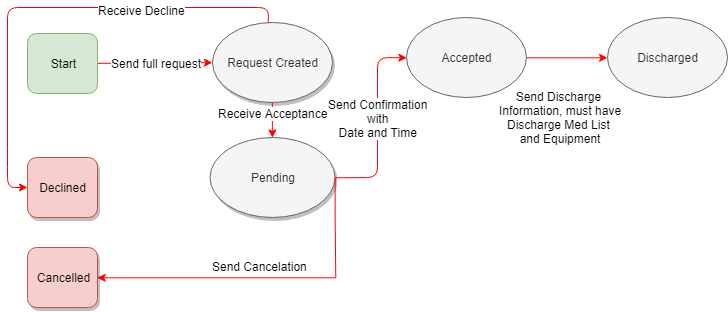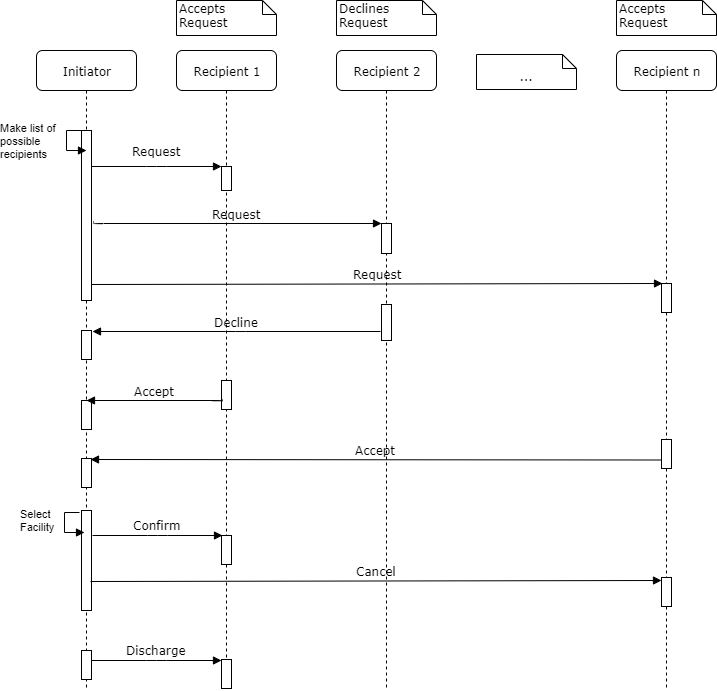This space is for the development of acute to long term care transfers based on 360X.
The starting point for the discussions are found in this Word document. The initial use case is for referrals from acute care facilities (hospitals) to skilled nursing facilities (SNF).
Currently there are no established standards for electronic communication and data exchange between the acute care facilities and skilled nursing facilities. The selection of an appropriate SNF, and the transfer of care for the patient is, therefore, prone to inefficiencies, unnecessary delays, and potentially missing relevant clinical and medical information. The following key points form the basis of the specification for Long Term Care Transfers using 360X.
It is not uncommon for the hospital to contact several SNFs and then choose the best match based on a variety of criteria. The specification needs to support the process of sending a referral request to multiple recipients, the subsequent choice, and informing the rest that they have not been selected.
Another common practice is for the initial request to contain only basic information regarding the patient and the specific requirements for the facility. Once the specific SNF is chosen, the more comprehensive clinical documentation is sent to the facility. There doesn't seem to be a good reason to replicate this process when done electronically. This specification requires the sending of a single comprehensive request to all facilities, which, in turn, must accept or decline the request.
Skilled nursing facilities need to be aware of any specific requirements needed to take care of the patient. Sometimes called "Red Flags", these pre-placement requirements usually fall in three main categories - pain management, special equipment, and expensive medications. The specification needs to describe how this information will be sent as part of the initial request.
Once the patient has been admitted in the skilled nursing facility, there is a need to close the loop. Unlike the case of a specialist referral, it is not common for the transfer initiator (the acute facility) to manage the long term care for the patient. At the same time, there usually is a provider or a healthcare organization who need to be informed of the patient status, and for future care coordination among providers. The specification needs to describe what closing the loop means, and to recommend the best ways to transition to care coordination.
There are several distinct steps in the process from requesting a referral to a skilled nursing facility to getting the patient to the best possible facility for their care. The following diagram shows the transaction flow from the point of view of the requester. (Note: this is work in progress, and not all transactions have been represented yet)

The following diagram shows an example of the possible sequences of messages from the initiator to multiple recipients:

The referral request to a skilled nursing facility may be sent to multiple facilities. In order to enable the appropriate matching of the responses and allow for automation whenever possible, this implementation guide requires that each referral request contains a different unique referral ID. There are different ways to accomplish this in the initiator's system (e.g. parent referral order with multiple child orders, single referral order with a table correlating the IDs and the facilities, etc.) and different implementations can chose what is best for their purposes.
The request shall contain the full 360X request package. The C-CDA document shall contain the current clinical information in a discharge summary format, even though the discharge had not have occurred yet. The HL7 v2 message will contain the referral order information,and will contain the pre-placement requirements for the patient. (Discussion point: Would the C-CDA document be a better place for the pre-placement requirements?)
Upon receiving the request, each facility shall either accept or decline the referral, and send the appropriate notification. The initiator shall match the responses and, at any point after receiving the first accept notification, they can make their choice according to local business or jurisdictional requirements.
Once the choice is made, the initiator shall send a confirmation notification to the facility which will be taking care of the patient. The confirmation notification shall contain the date and time when the patient will be transferred. The initiator shall also send cancel notifications to the facilities, which had not already declined the request.
The Confirmation Notification transaction contains a single OSU^O51 message, where ORC-1 will be set to the code SC (status change), and ORC-5 will be set to the code SC (in process, scheduled).
The Discontinue Notification transaction is different from the general Cancellation Request in the base 360X specification in that there is no response expected. It contains a single OSU^O51 message, where ORC-1 will be set to the code DC (discontinue), and ORC-5 will be set to the code CA (cancelled).
At the time of discharge, the referral initiator shall send the currently available discharge information in a discharge summary format, even if the formal discharge summary has not been completed yet. The C-CDA shall contain the properly reconciled discharge medications, and any relevant medical equipment.
Once the complete discharge summary is ready (possibly several days after the patient has been transferred to the SNF), it is sent to the facility, with an indication that the transfer is now considered complete, and the loop is closed. This will include all notes and final diagnostic test results.